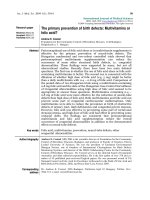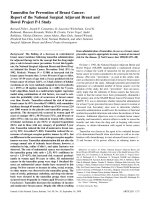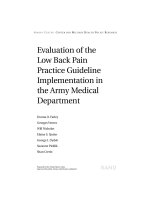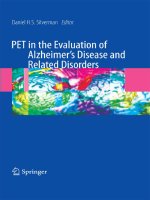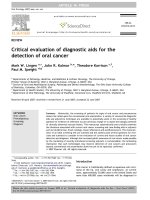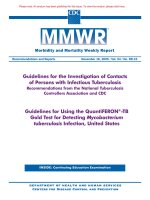Evaluation of the Effectiveness of the National Prevention of Mother-to-Child Transmission (PMTCT) Programme on Infant HIV measured at Six Weeks Postpartum in South Africa pot
Bạn đang xem bản rút gọn của tài liệu. Xem và tải ngay bản đầy đủ của tài liệu tại đây (4.89 MB, 80 trang )
EVALUATION OF THE EFFECTIVENESS OF THE
NATIONAL PREVENTION OF MOTHER-TO-CHILD TRANS-
MISSION (PMTCT)
PROGRAMME ON INFANT HIV MEASURED AT SIX WEEKS
POSTPARTUM IN SOUTH AFRICA
Medical Research Council, South Africa
School of Public Health, University of the Western Cape,
National Department of Health, South Africa
Centers for Disease Control and Prevention/PEPFAR
National Institute for Communicable Diseases/National Health Laboratory Service
Wits Paediatrics HIV Diagnostics
UNICEF
Evaluation of the Effectiveness of the National
Prevention of Mother-to-Child Transmission
(PMTCT) Programme at Six Weeks Postpartum
in South Africa
2010
FINAL REPORT
Medical Research Council, South Africa
School of Public Health, University of the Western Cape,
National Department of Health, South Africa
Centers for Disease Control and Prevention/PEPFAR
National Institute for Communicable Diseases/National Health Laboratory
Service
Wits Paediatrics HIV Diagnostics
UNICEF
Evaluation of the Effectiveness of the National
Prevention of Mother-to-Child Transmission
(PMTCT) Programme Measured at Six Weeks
Postpartum in South Africa
2010
Medical Research Council, South Africa
School of Public Health, University of the Western Cape,
National Department of Health, South Africa
Centers for Disease Control and Prevention/PEPFAR
National Institute for Communicable Diseases/National Health Laboratory Service
Wits Paediatrics HIV Diagnostics
UNICEF
ii
Report Prepared by:
Principal Investigators
Ameena Goga
Thu-Ha Dinh
Debra Jackson
SAPMTCTE Study Group
Yogan Pillay
Gayle Sherman
Adrian Puren
Nonhlanhla Dlamini
Thabang Mosala
Siobhan Crowley
Carl Lombard
Selamawit Woldesenbet
Vundli Ramokolo
Wesley Solomon
Wondwossen Lerebo
Tanya Doherty
Thurma Goldman
Jeffrey Klausner
Katherine Robinson
Nathan Shaffer
Mickey Chopra
iii
Copyright
Copyright 2012. All material in this report may be reproduced and copied for
non-commercial purposes: citation as to source, however, is required.
This report is disseminated by the South African Medical Research Council, National Department of
Health South Africa and PEPFAR/US Centers for Disease Control & Prevention.
Suggested citation
Goga AE, Dinh TH, Jackson DJ for the SAPMTCTE study group. Evaluation of the Effectiveness of the
National Prevention of Mother-to-Child Transmission (PMTCT) Programme Measured at Six Weeks
Postpartum in South Africa, 2010. South African Medical Research Council, National Department of
Health of South Africa and PEPFAR/US Centers for Disease Control and Prevention. 2012.
ISBN: 978-1-920014-87-2
iv
CONTENTS
PRIMARY CONTACTS/PRINCIPAL INVESTIGATORS…………………………………………………………………………….vii
ACKNOWLEDGEMENTS…………………………………………………………………………………………………………………….vii
ABBREVIATIONS AND ACRONYMS………………………………………………………………………………………………… viii
EXECUTIVE SUMMARY……………………………………………………………………………………………………………………….x
Introduction x
Aims and Objectives x
Methods x
Results xi
Conclusions and Recommendations xi
FOREWORD BY MINSTER OF HEALTH…………………………………………………………………………………………… xiii
DEFINITIONS…………………………………………………………………………………………………………………………………… xv
1. INTRODUCTION 1
2. METHODOLOGY 4
2.1 Survey Design and Justification 4
2.2 Study Population and Inclusion/Exclusion Criteria 5
2.3 Sampling 5
2.4 Data Collection Tools 6
2.5 Ethical Considerations 6
2.6 Data Collection Methods 7
2.7 Laboratory Methods 9
2.8 Quality Control of Field Work 10
2.9 Data Management 10
2.10 Data Analysis 11
3. RESULTS 12
3.1 Sample Realisation and Survey Profile 12
3.2 Sample Description and Characteristics 13
3.3 Infant HIV Infection Prevalence 16
3.4 National and Provincial Infant HIV Exposure and MTCT Rates 16
3.5 National PMTCT Programme Cascade 17
3.6 Demographic Characteristics, MTCT and the PMTCT Cascade by Province 20
3.7 Infant Feeding 38
4. DISCUSSION 40
4.1 Infant HIV Exposure 40
4.2 Mother-to-Child Transmission of HIV 40
4.3 PMTCT Cascade 42
4.4 Early Infant Diagnosis 43
4.5 Infant Feeding 43
5. STRENGTHS AND LIMITATIONS OF SAPMTCTE 44
Strengths 44
v
Limitations………………………………………………………………………………………………………………………………… 44
6. CONCLUSION AND RECOMMENDATIONS 45
REFERENCES…………………………………………………………………………………………………………………………………….47
CO-INVESTIGATORS…………………………………………………………………………………………………………………………50
SAMPLE SIZE CALCULATION BY PROVINCE……………………………………………………………………………………….52
SAMPLING……………………………………………………………………………………………………………………………………….53
TABLES
Table 1 2010 South African national PMTCT regimens 2
Table 2 Studies conducted on PMTCT effectiveness, SA, 2001-2009 2
Table 3 Data collection start and end dates in each province 7
Table 4 2010 SAPMTCTE desired and actual sample size by province 12
Table 5 Selected socio-demographic observations of 2010 SAPMTCTE [# (%)] 14
Table 6 Weighted Infant HIV infection prevalence nationally and by province 16
Table 7 Weighted infant HIV exposure and 4-8 week (early) MTCT of HIV by province 17
Table 8 HIV testing & results among pregnant women (weighted analysis)…………………………………… 18
Table 9 PMTCT programme in reported HIV-positive mothers (weighted analysis) 19
Table 10 Baseline characteristics of Eastern Cape SAPMTCTE survey participants 21
Table 11 Baseline characteristics of Free State SAPMTCTE survey participants 22
Table 12 Baseline characteristics of Gauteng SAPMTCTE survey participants 24
Table 13 Baseline characteristics of KwaZulu-Natal SAPMTCTE survey participants 26
Table 14 Baseline characteristics of Limpopo SAPMTCTE survey participants 28
Table 15 Baseline characteristics of Mpumalanga SAPMTCTE survey participants 30
Table 16 Baseline characteristics of Northern Cape SAPMTCTE survey participants 32
Table 17 Baseline characteristics of North West SAPMTCTE survey participants 34
Table 18 Baseline characteristics of Western Cape SAPMTCTE survey participants 36
Table 19 Infant feeding practices amongst HIV exposed infants over the past 8 days by province 39
FIGURES
Figure 1 Using ELISA at biomedical marker to identify HIV-exposed infants 4
Figure 2 Design phase and data collection flow diagram for the cell-phone data collection system 8
Figure 3 Example of SAPMTCTE Mobile Researcher web-based interface 8
Figure 4 2010 SAPMTCTE study profile 13
Figure 5 PMTCT service uptake (PMTCT cascade) in South Africa 20
Figure 6 PMTCT service uptake (PMTCT cascade) in the Eastern Cape 22
Figure 7 PMTCT service uptake (PMTCT cascade) in the Free State 24
Figure 8 PMTCT Service Uptake (PMTCT cascade) in Gauteng 26
vi
Figure 9 PMTCT service uptake (PMTCT cascade) in KwaZulu-Natal 28
Figure 10 PMTCT service uptake (PMTCT cascade) in Limpopo 30
Figure 11 PMTCT service uptake (PMTCT cascade) in Mpumalanga 32
Figure 12 PMTCT service uptake (PMTCT cascade) in the Northern Cape 34
Figure 13 PMTCT service uptake (PMTCT cascade) in the North West Province 36
Figure 14 PMTCT service uptake (PMTCT cascade) in the Western Cape Province 38
Figure 15 Maternal antenatal HIV prevalence by province in South Africa 40
Figure 16 NHLS Early Infant Diagnosis PCR <2 months old 2008-2010 (from Sherman, 2010) 41
vii
PRIMARY CONTACTS/PRINCIPAL INVESTIGATORS
Ameena Goga, MD
Paediatric Epidemiologist
Medical Research Council, SA
Address: 1 Soutpansberg
Road, Pretoria, 0001,
Phone: +2782 302 3168
e-mail:
Thu-Ha Dinh, MD, MS
Medical Epidemiologist
Centers for Disease Control and
Prevention
Address: 1600 Clifton Rd
Atlanta, 30333
Phone: +1 404 639 8618
+2712 424 9000
e-mail: ;
Debra Jackson, RN MPH DSc
Professor (Extraordinary)
School of Public Health
Univ. of the Western Cape
Address: PBX17 Modderdam
Road, Bellville 7535
Phone: +2783 327 7331
e-mail:
ACKNOWLEDGEMENTS
CDC and PEPFAR for technical and financial support.
UNICEF for financial support.
CHAI for funding the situational assessment that preceded this survey.
NICD/NHLS for conducting the validation ELISA testing on DBS samples; for providing
consumables for the survey and for performing all the DBS ELISA and PCR testing. In
particular thanks go out to Ms Beverly Singh. Ushimta Patel and Ewalde Cutler.
Ms Tsakani Mhlongo for training data collectors on infant blood drawing procedures.
The National and Provincial Departments of Health.
District and facility managers who provided support for the SAPMTCT Evaluation.
Mothers and their infants who participated in the survey.
MRC survey supervisors and data collectors.
WHO for protocol support.
viii
ABBREVIATIONS AND ACRONYMS
AIDS Acquired Immunodeficiency Syndrome
ANC Antenatal Care
ART Antiretroviral therapy
ARV Antiretroviral (drug)
BCC Behaviour Change Communication
CDC Centers for Disease Control and Prevention
CHAI Clinton Health Access Initiative
DBS Dried Blood Spot
DHIS District Health Information System
DHS Demographic and Health Survey
DNA PCR DNA-based Polymerase Chain Reaction Test
EBF Exclusive Breast-Feeding
EID Early Infant Diagnosis
ELISA Enzyme-linked Immunosorbent Assay
HAART Highly Active Antiretroviral Therapy
HIV Human Immunodeficiency Virus
HIER Health Information, Evaluation & Research
HSRC Human Sciences Research Council
HSRU Health Systems Research Unit of the Medical Research Council
IMCI Integrated Management of Childhood Illnesses
LPT Late Post-partum Transmission
M&E Monitoring and Evaluation
MCWH Maternal Child & Women’s Health
MCH Maternal and Child Health
MDG Millennium Development Goals
MPH Masters in Public Health
MRC Medical Research Council
MTCT Mother-to-child transmission (of HIV)
NDOH National Department of Health
NHLS National Health Laboratory Service
NICD National Institute for Communicable Diseases
NRF National Research Foundation
NSP National Strategic Plan, South Africa, 2007-2011
PEPFAR President’s Emergency Plan For AIDS Relief
PITC Provider-Initiated Testing and Counseling
PSU Primary Sampling Unit
PMTCT Prevention mother-to-child transmission of HIV
RtHC Road to Health Chart
SAPMTCTE South African Prevention of Mother-to-Child Transmission Evaluation
Sd-NVP Single-dose Nevirapine
ix
SoPH School of Public Health, University of the Western Cape
UNICEF United Nations Children’s Fund
UNGASS United Nations General Assembly, Special Session
UWC University of the Western Cape
WHO World Health Organisation
x
EXECUTIVE SUMMARY
Introduction
Within ten years of implementing the national Prevention of Mother-to-Child Transmission of HIV
(PMTCT) programme in South Africa interventions to prevent mother-to-child transmission (MTCT)
of HIV are now offered in more than 95% of public antenatal and maternity facilities country-wide.
However, this is the first national evaluation to determine the effectiveness of the National PMTCT
programme. The 2010 South African PMTCT Evaluation (SAPMTCTE) will serve as a baseline to
monitor the effectiveness of the antenatal and intrapartum aspects of the national PMTCT
programme (i.e., early MTCT rates). The survey will be repeated in 2011 and 2012 (during which
postnatal transmission at 6, 9, 12 and 18 months will also be measured) to track progress with
reduction in MTCT rates during pregnancy, labour and delivery, and postpartum. This will provide a
field-based, systematic approach to estimating the overall population-based transmission rate and
the number of new paediatric infections at 4-8 weeks of infant age.
Aims and Objectives
The overall aim of this evaluation was to conduct a national facility-based survey to monitor the
effectiveness of the South African National PMTCT programme. The primary objective was to
measure rates of early MTCT of HIV at six weeks postpartum. The secondary objective was to
periodically estimate coverage of key PMTCT interventions and services (e.g., HIV testing, CD4 cell
count testing, infant antiretroviral (ARV) prophylaxis, infant feeding counselling).
Methods
A cross-sectional facility-based survey was conducted at immunisation service points at public
primary health care/community health centres (PHC/CHC) in all nine provinces. This methodology
was chosen as immunisation uptake at 6 weeks is >99% in South Africa. The survey aimed to capture
known and unknown HIV-exposed infants, as well as PMTCT participants and non-participants. A
biomedical marker (HIV enzyme-linked Immunosorbent Assay (ELISA) tests to identify HIV antibody)
was used to identify HIV-exposed infants from infant dried blood spot (DBS) specimens. All DBS
specimens reactive on ELISA testing were sent for DNA-based polymerase chain reaction tests (DNA
PCR) to determine infant HIV infection status.
Infants aged 4-8 weeks attending PHC/CHC facilities for their six week immunisation were included.
Hospitals and mobile clinics, very sick infants or infants aged <4 weeks or >8 weeks were excluded.
The immunisation data from the 2007 District Health Information System (DHIS) were used to
quantify the number of children that could be expected within facilities over a period of time and
then stratify by size. Sample size was calculated so that valid national and provincial level estimates
of MTCT could be ascertained. This resulted in between 34-79 facilities per province, 580 in total.
Facilities were randomly selected within strata with probability proportional to size (3 strata).
Caregiver/infant pairs were consecutively or randomly selected from facilities (depending on facility
xi
size). Interviews were conducted and infant DBS drawn after receiving consent from caregivers for
study participation. Mothers and infants were referred into HIV care, as appropriate. Data were
collected using low cost cell phones and interview data were uploaded real time into a web-based
database console. Analysis was weighted for sample realisation and at provincial level proportional
to the live birth distribution of South Africa.
Results
A total of 10 820 eligible infants were identified from 572 facilities. Of these, 10 735 interviews were
conducted and 10 178 (94%) DBS were drawn and analysed.
The national weighted infant HIV-exposure prevalence was 32.0% (95% CI 30.7-33.3%).
The national weighted MTCT rate measured at 4-8 weeks of infant age was 3.5% (95% CI 2.9-
4.1%).
The MTCT rate across provinces ranged from 1.4% to 5.9%.
Among mothers who reported being HIV negative, 4.1% had HIV-exposed infants.
Of all women participating 98.8 (95% CI 98.5-99.0%) received an HIV test during pregnancy
and of these 98.6 (95% CI 98.4-98.9) got their HIV test results.
Of the reported HIV-positive mothers 78.3% had a CD4 cell count done during pregnancy
and 91.8% received either maternal highly active antiretroviral therapy (HAART) or
mother/baby antiretroviral (ARV) prophylaxis.
Only 35.1% intended to access early infant diagnosis services and 89% had received infant
feeding counselling.
Among HIV-positive women, 20% were exclusively breastfeeding, 62% formula feeding and
18% mixed feeding in the 8 days prior to the interview.
Conclusions and Recommendations
1. The national PMTCT survey found a 3.5% national MTCT rate in pregnancy and intrapartum
with a greater than 4-fold differential range of rates across the nine provinces (1.4% to
5.9%).
2. Maternal HIV acquisition since the last HIV test was potentially high at 4.1% and therefore
repeat HIV testing at 32 weeks pregnancy and couple testing is critical. Further data should
collected to assess the contribution of false negative rapid test results to maternal potential
HIV acquisition. In addition, more work is required to improve the quality of rapid HIV
testing in the field.
3. Uptake of PMTCT services is high, with more than 98% of women getting HIV tested during
pregnancy and 91.7% of HIV-positive mothers receiving ARV treatment or prophylaxis.
However CD4 (78.3%) testing and early infant diagnosis (EID) (35.1%) uptake are lower and
represent on-going missed opportunities in the PMTCT programme.
4. Early infant HIV testing uptake is high if offered to all infants (94%) at six-week immunisation
visits, indicating that EID strategies that routinely offer infant HIV testing only to known HIV-
exposed infants should be reviewed.
xii
5. Given the measured MTCT rate in the early implementation phase of the revised 2010 South
African PMTCT guidelines, virtual elimination of paediatric HIV infection is possible with
intensified effort. However, postnatal transmission after 6 weeks also needs to be examined
to assess achievement of <5% MTCT at 18 months of infant age.
6. Only 20% of HIV-positive women were exclusively breastfeeding, 62% were formula feeding
and 18% were practicing high-risk mixed feeding, suggesting a need for increased attention
to infant feeding.
xv
DEFINITIONS
Caregiver
The person who feeds and looks after the child most of the week. This
includes parents, legal guardians, family members, nannies or friends
who routinely feed, bath, change nappies, or in particular reference to
this study, bring the child for routine health services.
The Consortium
Health Systems Research Unit (HSRU) of the Medical Research Council
(MRC) and School of Public Health of the University of the Western Cape
(SoPH, UWC).
Early (4-8 weeks) HIV
transmission rate among
HIV-exposed infants
Number of DNA PCR positive infants and ELISA positive infants divided
by the number of ELISA positive infants at 4-8 weeks.
Health care personnel
Health care providers and health care workers.
Health care provider
Any person providing health services in terms of any law, including in
terms of the:
Allied Health Professions Act, 1982 (Act No.63 of 1982),
Health Professions Act, 1974 (Act No. 56 of 1974),
Nursing Act, 2005 (Act No. 33 of 2005),
Pharmacy Act, 1974 (Act No. 53 of 1974), and
Dental Technicians Act, 1978 (Act No. 19 of 1979).
Health care worker
Any person who is involved in the provision of health services to a user,
but is not a health care provider. This includes lay counselors and
community caregivers.
HIV-exposed infant
An infant born to a known HIV-positive mother and/or having a positive
HIV antibody test result using DBS ELISA. Infant HIV exposure prevalence
serves as an indirect marker of maternal HIV prevalence.
HIV-infected infant
An HIV-exposed infant having a positive HIV DNA PCR result.
HIV-uninfected infant
An HIV-exposed infant having a negative HIV DNA PCR result. (Note: In
many cases, there is on-going risk of postnatal transmission through
breastfeeding, so an early DNA PCR result indicates infection status at
the time of the test, but not the final infection status).
HIV-positive mother
Defined for this survey as mothers whose infants have a positive DBS
ELISA.
HIV status unknown
Refers to people (including children) who have not taken an HIV test or
who do not know the result of their test.
Infant
A child from birth to 12 months of age.
Infant HIV infection
prevalence
Proportion of confirmed HIV-positive (infected) infants among all infants
tested during the study period, measured as number of positive DNA PCR
xvi
infant DBS divided by the total number of ELISA samples tested. In this
study infant HIV infection prevalence at 6 weeks will be measured in
infants age 4 to 8 weeks, who are attending routine immunisation clinic.
It will be measured as a point prevalence with the numerator defined as
those infants with a positive HIV DNA PCR test and the denominator of all
infants tested using HIV ELISA on dried blood spots in the study.
Maternal HIV prevalence
Number of positive (infant) DBS ELISA divided by total number of ELISA
samples tested.
Maternal HIV
Incidence/Maternal
potential HIV acquisition
during pregnancy
The number of positive infant DBS ELISA among mothers reporting an
HIV-negative status during the interview divided by total number of
mothers reporting an HIV-negative status during the interview. This
indicator is likely a combination of the following scenarios: (i) mothers
who do not wish to admit positive status and report being HIV negative;
(ii) mothers who were tested during the window period; (iii) poor
quality control or performance of rapid tests in the field causing false
negative results at antenatal care (ANC) on HIV-infected
women. Reported field sensitivities are as low as 87% to 95% depending
on the rapid test used; and (iv) true acquisition of HIV after the last HIV
test.
Mother-to-child
transmission (MTCT)
Transmission of HIV from an HIV-positive woman to her infant during
pregnancy, delivery or breastfeeding. The term is used because the
immediate source of the infection is the mother, and does not imply
blame on the mother.
MTCT rate
Defined for this survey as a numerator of HIV-positive infants (PCR
positive) and denominator of HIV-exposed infants (infant ELISA antibody
positive).
Routine offer of
counselling and testing
HIV testing that is routinely offered to all ANC clients. Health care
personnel provide group information first, followed by individually
offering HIV tests. The patient/client has the option to decline testing at
any stage of this process. The patient/client receives post-refusal
counselling or post-test counselling as appropriate.
Transmission in PMTCT
programme
Number of positive DNA PCR and positive ELISA divided by the number
of ELISA positive mothers who recall taking ARV prophylaxis or HAART
during pregnancy/delivery.
Transmission in those not
participating in PMTCT
Programme (missed
opportunities)
Number of positive DNA PCR and positive ELISA divided by number of
mothers who do not recall taking ARV prophylaxis or HAART during
pregnancy/delivery.
1
1. INTRODUCTION
Internationally and nationally PMTCT has been recognised as an essential intervention to reduce HIV
incidence in the population and to virtually eliminate new HIV infections in children. In 2010 the
WHO Global Elimination of MTCT Initiative (WHO/UNICEF/UNFPA/UNAIDS, 2011) aims, inter alia, to
reduce new paediatric HIV infections by 90% from the 2009 estimated baseline and reduce the
overall, population-based HIV transmission rate (through MTCT) to <5% (<2% in the absence of
breastfeeding or as measured at 6 weeks). The South African National Strategic Plan on HIV and
AIDS and STIs, 2007-2012 (NSP) (NDOH, 2007) prioritises scaling up coverage of PMTCT to reduce
MTCT to less than 5% by 2011.
In 2001 South Africa started implementing a programme to prevent HIV transmission from mother-
to-child at 18-pilot sites. The first interventions included single-dose nevirapine (Sd NVP) during
labour for the mother and to the baby within 72 hours of delivery; modified obstetric practices;
infant feeding counselling and the provision of free commercial infant formula to HIV-positive
mothers who avoided breastfeeding (NDOH, 2001). PMTCT interventions were scaled up in 2002 and
in 2008 the national antiretroviral regimens for pregnant women were improved to dual therapy
(AZT from 28 weeks with Sd-NVP at the outset of labour for pregnant women and Sd-NVP with AZT
for baby).
In 2010, PMTCT interventions were further modified as shown in Table 1 (NDOH/SANAC, 2010). The
2010 modifications included routine HIV testing and counselling for pregnant women, dual therapy
to prevent MTCT of HIV, HAART for pregnant women with CD4 cell count ≤350 cells/µl, postnatal
infant prophylaxis for breastfeeding HIV-positive women and intensified efforts to integrate PMTCT
services into routine maternal and child health (MCH) services. These efforts are to meet the NSP
targets of reducing the MTCT rate of HIV to less than 5% by 2011 and to meet the 4
th
and 6
th
Millennium Development Goals (MDGs) (i.e., ‘reduce by two thirds, between 1990 and 2015, the
under-five mortality rate’ and ’have halted by 2015 and begun to reverse the spread of HIV/AIDS’)
(UN, 2011).
2
Table 1 2010 South African national PMTCT regimens
HIV-infected pregnant women
Mother
Start all HIV-positive pregnant women on AZT at 14 weeks
Pregnancy
CD4 cell count≤350 or WHO clinical stage
3 or 4: HAART
Note: WHO stages are defined at the end
of this section, for your information
CD4 cell count>350 and WHO stage
1 or 2
Start AZT. Same day referral to ARV clinic
for HAART. Stop AZT once HAART
initiated
Continue AZT 300 mg 12 hourly
Labour and
delivery
Continue HAART as usual during labour
Single dose nevirapine (200mg) at
onset of labour + AZT 300mg 12
hourly until the neonate is delivered
Postnatally
Continue HAART as usual
TDF + FTC (Truvada) single dose
(stat) after delivery
HIV-exposed infants
Mother breastfeeds
(and not on HAART)
Mother meets specified criteria and does not
breastfeed
Daily infant nevirapine throughout the
breastfeeding period until 1 week after
breastfeeding stops
Daily infant nevirapine for 6 weeks only
Within ten years of implementing the national PMTCT program in South Africa, PMTCT interventions
are now offered in more than 95% of antenatal and maternity facilities country-wide. Small scale
evaluations of MTCT rates have been conducted since 2001 (Table 2) providing results of PMTCT
effectiveness at selected sites.
The National Health Laboratory Service (NHLS) report on PCR positivity at all sites offering PCR
testing for infants. In addition, routine DHIS data provide information on the PMTCT programme but
lack fixed denominators to calculate transmission, and thus PMTCT effectiveness, reliably.
Consequently, there is not been a national evaluation to determine the effectiveness of the National
PMTCT programme prior to the 2010 SAPMTCTE.
Table 2 Studies conducted on PMTCT effectiveness, SA, 2001-2009
<2007
2008
2009
Sherman (2009) Rahima Moosa
Hospital record review. (2001-2002) Sd NVP
8.0%
6 weeks
Sherman (2004) Coronation
Hospital record review (2001-2002) Sd NVP
8.7%
6 weeks
3
<2007
2008
2009
Coetzee (2006) Khayelitsha
AZT from 34 wks (March-November 2003)
8.8%
6-10 wks
Colvin (2007) Good Start study:
3 sites (P, R, U). Prospective cohort study
(Oct 2002-Nov 2004)
P: 8.6% (4.5–
14.5)
R: 13.7% (8.9–
19.8)
U: 11.9%
(8.3–16.3)
Rollins (2007& 2009) KZN MTCT
7 clinics Aug 04–July ‘05
3 PHC facilities Nov ‘07- Feb ‘08,
20.2%
4-8 weeks
21.9%
4-8 weeks
Sherman (2010) National MTCT NHLS data ≤
2months
8.2%
5.8%
The 2010 SAPMTCTE will serve as baseline, and progress will be monitored over two subsequent
years during which postnatal transmission will also be measured and field estimates of overall
population-based transmission and new paediatric HIV infections will be calculated.
The 2010 SAPMTCTE aimed to conduct a facility-based survey to monitor the effectiveness of the
South African National PMTCT programme. The primary objective of the 2010 SAPMTCTE was to
measure rates of early MTCT of HIV at 4-8 weeks postpartum. The secondary objective was to
periodically estimate coverage of key PMTCT interventions and services (e.g., HIV testing, CD4 cell
count testing, infant ARV prophylaxis, infant feeding counselling).
4
2. METHODOLOGY
2.1 Survey Design and Justification
A cross-sectional facility-based survey, using a biomedical marker to determine MTCT rate, was
conducted. The survey was conducted among caregiver-infant pairs who presented at their local
primary health care facility for their infant’s six-week immunisation (1
st
DTP dose) visit. South Africa
reports >95% coverage of six week immunisation (1
ST
DTP dose) (WHO, 2011), making these clinics
an ideal catchment point for young infants of known or unknown HIV exposure status. This
provided a convenient sample to determine overall PMTCT effectiveness with relatively limited
selection bias.
This methodology has been proven effective in a South African context. Based on the approach
recommended by Rollins et al. (2007 & 2009) we used a biomedical marker to identify infants
exposed to HIV. Chantry et al. (1995) found that sero-reversion for ELISA in HIV-exposed infants was
not seen prior to 17 weeks of age suggesting that most, if not all, infants aged 4-8 weeks will still
have maternal antibodies in their bloodstream. This means that screening infants for the presence of
HIV antibody would be a direct measure of infant HIV exposure and an indirect measure of maternal
HIV infection prevalence.
Figure 1 Using ELISA at biomedical marker to identify HIV-exposed infants
Mom's HIV antibody
5
This evaluation thus aimed to provide:
1) A valid estimate of MTCT and HIV infection prevalence in children aged 4-8 weeks, and
2) A reasonable estimate of coverage of key PMTCT programme indicators through 6 weeks
postpartum.
2.2 Study Population and Inclusion/Exclusion Criteria
The study population comprised infants aged 4-8 weeks and their caregivers visiting public health
facilities for the infant’s 1
st
DTP dose between June-December 2010.
Inclusion Criteria
Study participants included 4-8 week old infants attending clinic for 1st DTP immunisation.
Caregivers had to consent to participation (consent for maternal or caregiver interview and/or infant
DBS).
Exclusion Criteria
Severely ill infants needing emergency medical care or urgent referral to the next level of care (e.g.,
infants who are vomiting everything or have convulsions; are lethargic or unconscious; or have
severe pneumonia or severe dehydration) were excluded from the study.
2.3 Sampling
Sampling Frame
The public health facilities were stratified as: < 130, 130-300 and >300 immunisations per year, and
data were extracted from the 2007 South African DHIS (Personal Communication C Hedberg, 2009).
A strategic decision was made to exclude the small facilities (<130 immunisations per year) from the
formal sampling frame. The 2008 national antenatal maternal HIV prevalence estimate of 29%
(NDOH, 2009) was used as the cut-off point for classifying facilities as above or below national
average for antenatal HIV prevalence. This stratification was only applied to facilities in the large
stratum (>300 immunisations per year). A total of 23 strata across province, facility size and
maternal HIV prevalence were utilised in the survey sampling frame and were sorted by province,
size and maternal HIV prevalence.
Sample Size
ANC maternal HIV prevalence (NDOH, 2009) and estimated MTCT rates from a KwaZulu-Natal survey
using similar methodology (Personal communication N. Rollins, unpublished data, 2009) were used
to determine the sample size for each province. Specifying relative precisions of 30% to 50% for the
expected MTCT rate across provinces plus a design effect of 2 indicated that a total sample size of 12
200 infant DBS specimens were needed. The sample size across provinces ranged from 1 800
(Gauteng) to 700 (Northern Cape).
6
Sampling
Stratified two-stage sampling was used. In the first stage, facilities (Primary sampling units - PSUs)
were randomly sampled proportional to size (PPS) within each stratum. The method operated under
the without-replacement-type selection (Lehtonen & Pakhinen, 1994). At the second stage a fixed
number of infants per a facility was sampled. The fixed number was the median number of infants
expected within the sampling window (three weeks) across the population of facilities within the
stratum as determined from the detailed information of the sampling frame above. The fixed
number of infants sampled in each facility within a stratum ensured a self-weighting sample. A
sampling window of 3 weeks was used to realize the required sample. (Appendix#1)
2.4 Data Collection Tools
Data were gathered using a questionnaire adapted from several validated tools (Rollins et.al., 2007
& 2009; HSRC, undated; Nyblade & MacQuarrie, 2006; Tlebere et.al., 2007; Jackson et al. 2007). The
questionnaire included information on maternal age, parity, socio-economic status, antenatal care,
HIV testing, maternal HIV status, PMTCT care during pregnancy and delivery, infant feeding
counselling, birth information, infant feeding practices, infant weight; immunisations, postnatal visits
and illness since birth. Fathers/legal guardians/non-maternal caregivers were administered a shorter
form of the questionnaire that excluded ANC and PMTCT information.
The study tool was piloted in the Western Cape and KwaZulu-Natal provinces to test it in English and
at least one other official/local languages. Approximately 5-10 participants were administered the
study tool in each language as part of the pilot. The primary objective was to test the flow of
questions and basic understanding by the participants. The cell phone technology used for data
collection, including skips and field data entry, was also examined and tested. Adjustments to the
tool and/or cell phone data entry platform were made after the pilot as necessary.
2.5 Ethical Considerations
Written, signed, informed consent for all procedures in the study was obtained from each eligible
caregiver for the interview and DBS sampling (separately). Informed consent was in the preferred
language of the participants. The information sheet was written in plain lay words that could be
easily understood by participants. A confidential Study ID was given to each participant and inserted
in consent forms, lab forms and questionnaire for the purpose of data linking and auditing, and to
provide the infants’ blood test results to mothers or legal guardians. Care was taken to ensure that
HIV-infected mothers who refused the study understood that their infant could be tested without
participating in the study.
Ethical approval was obtained from the Medical Research Council (26 February 2010) and from each
of the nine provincial research ethics committees. Ethical approval was also granted from the United
States Centers for Disease Control and Prevention Atlanta (April 2010).
7
2.6 Data Collection Methods
Data collection commenced at different times in each province (Table 3). All data collection was
completed by 1 December 2010.
Table 3 Data collection start and end dates in each province
Enrolment
Data collectors recruited mothers/caregivers from the PHC/CHC waiting room during immunisation
days. Data collectors introduced themselves and the study verbally and in written form using a
standardised information sheet. If the mother agreed to be interviewed, the interview was
conducted in a private location. Mother/Infant pairs attending the sampled facilities to receive the
infants’ DPT first dose vaccination were approached to enroll in the study. A screening questionnaire
was administered to determine eligibility and full informed consent forms were completed.
Cell Phone Technology for Data Collection
Electronic questionnaires were loaded on low-cost mobile phones using the Mobile Researcher
software management solution. The Mobile Researcher system consists of three components: the
handset, the web interface (data transport system) and web-based research console (Figure 2). The
handset is the device on which the questionnaires are entered. Minimum handset functionality is
ensured since phone is WAP (Wireless Application Protocol) enabled. The data is transferred via the
GPRS (General Packet Radio Services) network using the WAP platform on the mobile phone. The
web-based management console is a secure data capture centre that has controlled access.
Questionnaires were uploaded as they were completed to the central web management console and
then removed from the phone, while fieldworkers were in an area of mobile reception. In areas
where there was no mobile network reception, the questionnaire was stored on the phone until
reaching an area with adequate mobile network coverage when data would be automatically
DATA COLLECTION
Province
Commenced
Completion
KwaZulu-Natal
01-June-2010
22-Oct-2010
Eastern Cape
14-June-2010
12-Nov-2010
Western Cape
14-June-2010
22-Oct-2010
Free State
23-June-2010
12-Nov-2010
North West
23-June-2010
21-Oct-2010
Gauteng
28-June-2010
29-Oct-2010
Limpopo
29-June-2010
12-Nov-2010
Northern Cape
29-June-2010
01-Dec-2010
Mpumalanga
30-June-2010
29 Oct-2010
8
uploaded. The questionnaire responses were available on the web-based console every minute,
allowing for real-time monitoring of data collection progress and analysis (Figure 3).
Figure 2 Design phase and data collection flow diagram for the cell-phone data collection system
Figure 3 Example of SAPMTCTE Mobile Researcher web-based interface
